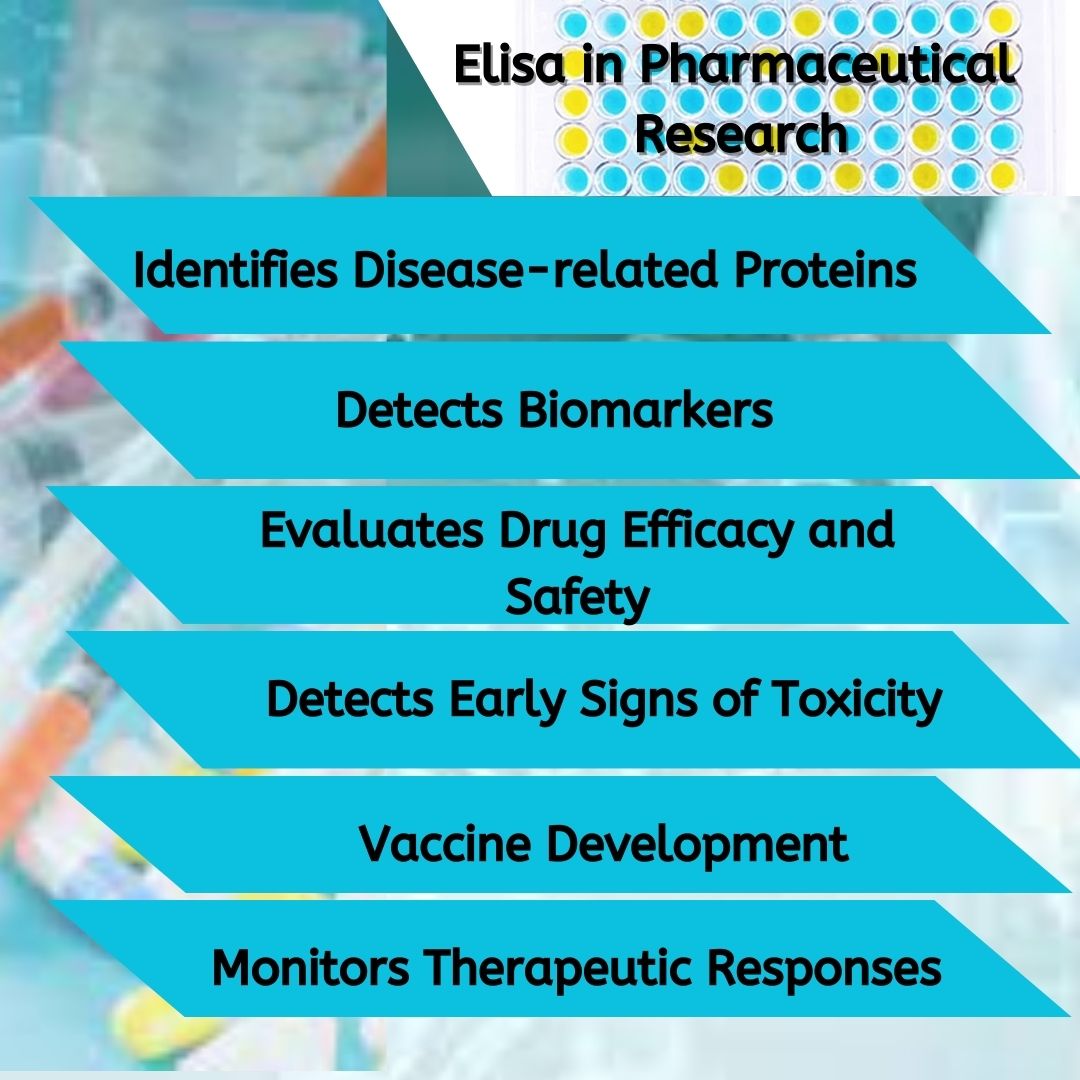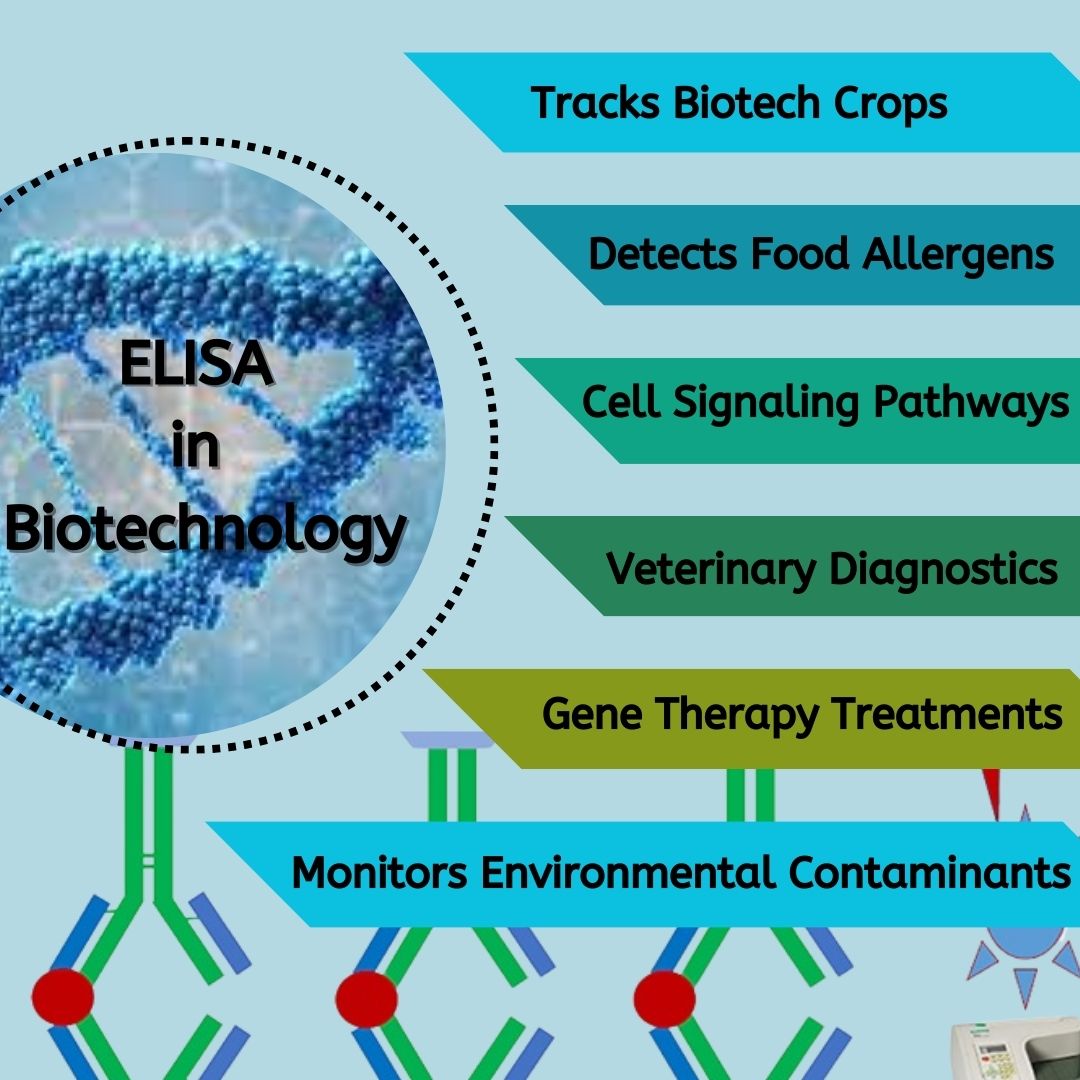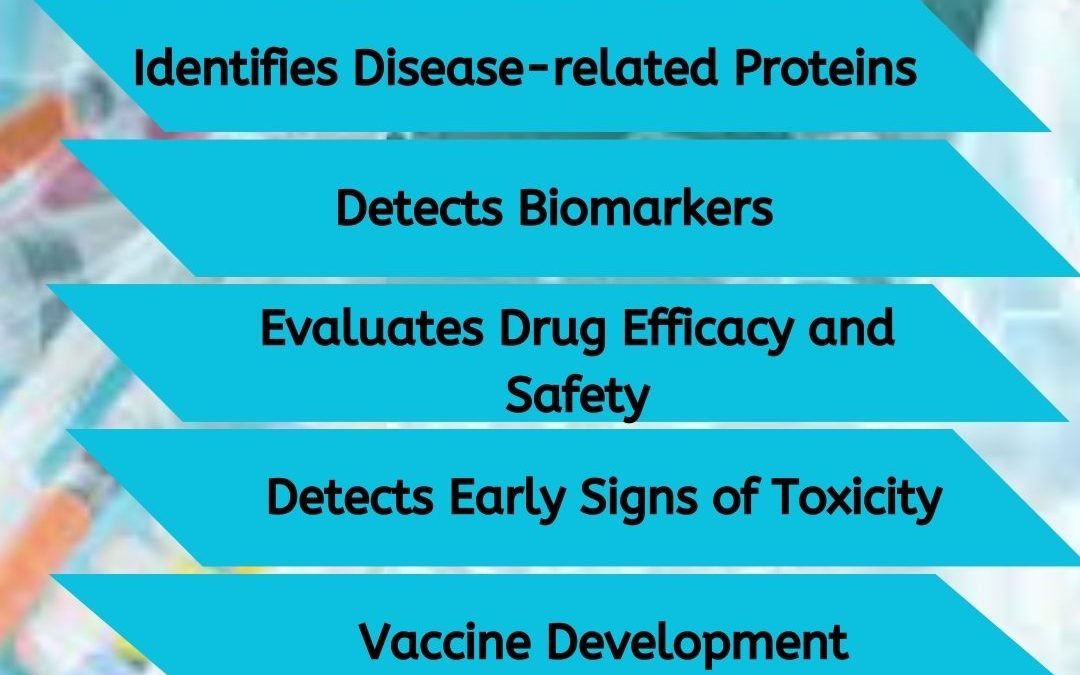Role of ELISA in Pharmaceutical Research:
-
ELISA helps identify a potential range of biomarkers essential for drug development, clinical trials, and post-market surveillance. For example, it measures BCAM, SIGLEC-14, and ANGPTL-3 levels in preterm infants at risk of bronchopulmonary dysplasia (BPD). This process involves analyzing samples from various tissues (fluids) to provide insights into disease progression. The impact of this technique is profound, enhancing early screening and intervention strategies. Scientists use this method to explore a range of diseases and to advance pharmaceuticals research.
-
ELISA can measure protein levels in biological samples from diseased and healthy subjects, helping researchers identify proteins associated with disease pathways. The analysis involves various techniques and methods to ensure accurate results. Different assay formats, such as sandwich assays, are used to improve reproducibility and quantification. The results are often read using a plate reader, and the response can be visualized as colorimetric changes on the plate surface. The choice of buffer and substrate plays a crucial role in the reaction’s efficiency. Various immunoassays and protocols are employed to achieve precise measurement of target proteins and epitopes.
-
In pre-clinical studies, ELISA detects biomarkers of toxicity, providing early indications of adverse effects and guiding the selection of safe drug candidates. This involves the use of different reagents and instruments to ensure reliable detection. Enzymes like alkaline phosphatase and horseradish peroxidase (HRP) are commonly used for signal generation. The binding of antibodies to target antigens in the wells of the plate is a critical step in this process, with adsorption and coating techniques influencing the results. The protocol often includes additional steps to account for different concentrations and types of substances.
-
Since the 1990s, ELISA has been crucial in Alzheimer’s disease research, quantifying how small molecules bind to Aβ aggregates. Advanced ELISA protocols replicate aqueous conditions to assess drug effects on AD-related proteins like Aβ. Sandwich assays and capture antibodies are often employed for precise analysis. Peptides and target molecules are key components in these studies. The format and principles of ELISA allow for a variety of applications in disease research, addressing both advantages and disadvantages.
-
ELISA assays for biomarkers like NT-proBNP and troponin are validated for their roles in diagnostics and monitoring heart failure and myocardial infarction, respectively. The validation of these assays ensures their accuracy in clinical settings. Literature and team input contribute to ongoing improvements in protocols, ensuring that each step of the procedure adheres to high standards. The review of references and protocols helps refine assay techniques and address any potential limitations.

- ELISA measures drug concentration in biological samples (e.g., blood and plasma) over time, essential for pharmacokinetic studies. It detects and quantifies drug metabolites, aiding in understanding drug metabolism. For instance, ELISA confirmed the long-lasting presence of HIV-targeting antibodies in the blood, optimizing clinical treatment dosing. Another study used ELISA to measure Interferon beta-1a levels, showing consistent biomarker responses to repeated subcutaneous doses. Enzymes like HRP are used for signal detection, and the reaction can be visualized through colorimetric changes that reflect the concentration of target molecules. The quantity of target antigen and the activity of the enzyme play a crucial role in this process.
Role of ELISA in Biotechnology:
-
Efficiency in Quality Control: Automated protocols make quality control in biopharmaceutical production more efficient and reliable by ensuring consistent and accurate potency tests. This involves rigorous testing and calibration of instrumentation to maintain high standards. The system’s reliability is crucial for accurate results. Factors such as reagent quality and assay conditions impact the overall effectiveness.
-
Adapting ELISA for Food Safety: Detecting microbial contamination in food processing requires adapting the assay to target specific microbial antigens, enhancing specificity and sensitivity for effective food safety measures. Cross-reactivity and detection antibody specificity are crucial considerations. Contaminants like bacteria and milk proteins are examples of targets for these assays, where the binding sites and competition between antibodies and antigens are carefully managed. Buffer solutions and specific agents are used to optimize reactions. The ability to adapt the method to different types of contaminants ensures accurate and reliable results.

-
Nanoparticle-Enhanced Performance: Recent studies explored how 50 nm citrate-capped silver nanoparticles can enhance ELISA performance for quantifying cancer testis antigens (CTAs), aiming to improve sensitivity and detection efficiency in laboratory medicine. Nanoparticle applications enhance quantitation and accuracy by improving the binding of antibodies to target antigens. The review of current technology and resources helps in refining these methods.
-
Immunoassay Methods for Biotech Crops: Immunoassay methods like ELISA and lateral flow tests quantify biotech crop proteins, crucial for managing grain distribution and compliance with labeling laws in the US. These applications help in monitoring target antigens in various crop varieties. The variety of ELISA formats ensures that different types of assays can be used for specific applications. The selection of appropriate substrates and assay conditions is vital for accurate measurements.
-
Selective Immunoextraction for Precision: Selective immunoextraction enhances ELISA sensitivity and specificity by concentrating analytes from complex samples, crucial for precise toxin detection in environmental monitoring and food safety. The use of advanced techniques and substrates ensures high-quality data. Workflow and components are critical to the process, ensuring that each step from sample preparation to plate reading is optimized for accuracy and reproducibility. The integration of new technologies and methodologies continually improves the efficiency of the process.
Explore Our Full Range of ELISA Kits
Whether you’re testing human, animal, or plant samples, MyBioSource offers over 1 million ELISA kits covering thousands of analytes across every major species.
References
- Pinho, A. R., Fortuna, A., Falcão, A., Santos, A. C., Seiça, R., Estevens, C., … Ribeiro, A. J. (2019). Comparison of ELISA and HPLC-MS methods for the determination of exenatide in biological and biotechnology-based formulation matrices. Journal of Pharmaceutical Analysis. doi:10.1016/j.jpha.2019.02.001
- Chen, Y.-H., Kuo, Z.-K., & Cheng, C.-M. (2015). Paper – a potential platform in pharmaceutical development. Trends in Biotechnology, 33(1), 4–9. doi:10.1016/j.tibtech.2014.11.004
- Sandra Maniam and Subashani Maniam “Screening Techniques for Drug Discovery in Alzheimer’s Disease”, ACS Omega 2024, 9, 6, 6059–6073 , Publication Date:February 4, 2024
- Eithar Mohamed, Daniel J García Martínez, Mohammad-Salar Hosseini, Si Qi Yoong, Daniel Fletcher, Simon Hart, Barbara-ann Guinn, Identification of biomarkers for the early detection of non-small cell lung cancer: a systematic review and meta-analysis, Carcinogenesis, Volume 45, Issue 1-2, January-February 2024, Pages 1–22,
- Du, J., YU, X., Zhang, W. et al. Plasma Biomarker Screening Based on Proteomic Signature of Patients with Resistant Hypertension. J. of Cardiovasc. Trans. Res. (2024)
- Kindt, A.S.D., Förster, K.M., Cochius-den Otter, S.C.M. et al. Validation of disease-specific biomarkers for the early detection of bronchopulmonary dysplasia. Pediatr Res 93, 625–632 (2023)
- Buchwalder, P.-A., Buclin, T., Trinchard, I., Munafo, A., & Biollaz, J. (2000). Pharmacokinetics and Pharmacodynamics of IFN-β1a in Healthy Volunteers. Journal of Interferon & Cytokine Research, 20(10), 857–866. doi:10.1089/10799900050163226
- Pagan, F. L., Hebron, M. L., Wilmarth, B., Torres-Yaghi, Y., Lawler, A., Mundel, E. E., … Moussa, C. (2019). Pharmacokinetics and pharmacodynamics of a single dose Nilotinib in individuals with Parkinson’s disease. Pharmacology Research & Perspectives, 7(2), e00470. doi:10.1002/prp2.470
- Mayer BT, Zhang L, deCamp AC, Yu C, Sato A, Angier H, Seaton KE, Yates N, Ledgerwood JE, Mayer K, et al. Impact of LS Mutation on Pharmacokinetics of Preventive HIV Broadly Neutralizing Monoclonal Antibodies: A Cross-Protocol Analysis of 16 Clinical Trials in People without HIV. Pharmaceutics. 2024; 16(5):594.
- Kimberly E Hanson, Angela M Caliendo, Cesar A Arias, Janet A Englund, Mary K Hayden, Mark J Lee, Mark Loeb, Robin Patel, Osama Altayar, Abdallah El Alayli, Shahnaz Sultan, Yngve Falck-Ytter, Valéry Lavergne, Rebecca L Morgan, M Hassan Murad, Adarsh Bhimraj, Reem A Mustafa, Infectious Diseases Society of America Guidelines on the Diagnosis of COVID-19: Serologic Testing (September 2020), Clinical Infectious Diseases, Volume 78, Issue 7, 15 June 2024, Pages e150–e169




